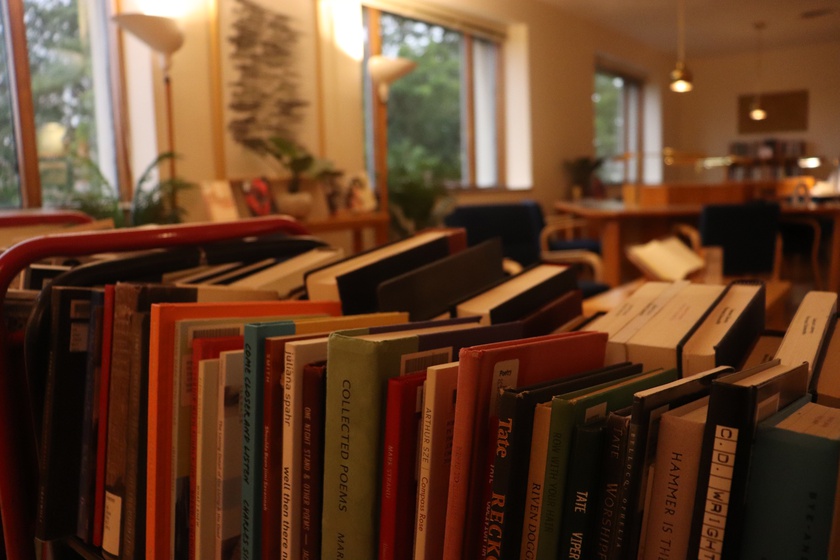{shortcode-607c78b48b9e1faf6f455a005978b06521376c11}
On the third floor of Lamont Library is a nondescript wooden door that encloses a century’s worth of unique history: the Woodberry Poetry Room. At first glance, the room may appear to be nothing unusual: a quiet place for study with large windows offering a view of Memorial Church’s steeple. But this unassuming room houses over 8,000 poetry books, 7,500 audio-visual recordings, and 100 literary magazines. Celebrating its 90th year, the collection reopened to the public on Oct. 4.
The Poetry Room, named in honor of poet and Harvard graduate George Edward Woodberry, Class of 1877, was established in 1931 on the third floor not of Lamont but of Widener Library. The room was originally created to provide “a center where students might gather to become more intimately acquainted with the poetry of their own time,” according to a 1941 report on the room by Arnold Kenseth, who was then Head Curator. It contained books, literary magazines, and manuscripts.
By 1933, the room became home to Harvard professor Frederick C. Packard Jr.’s Vocarium, or “library of voices,” a collection of original audio recordings of spoken poetry. The collection provided a new way for students to become intimately acquainted with poetry through the voices of the poets themselves. Kenseth’s report on the room declares that “from the point of view of its size, its equipment, and its availability to listeners, the collection is without rival.”
As the spoken poetry collection brought the Woodberry Room further into the spotlight, the library’s presence expanded both in the University and beyond. In 1939, the Woodberry Room began to host events to foster community such as lectures, poetry readings, and student writing presentations. The Poetry Room’s newfound popularity soon demanded a larger space. In 1949, the new Woodberry Poetry Room, designed by renowned Finnish architect Alvar Aalto, opened in Lamont Library.
Over 70 years later, the room appears as though frozen in time. The walls are lined with collections of twentieth and twenty-first poetry. Comfortable blue velvet chairs are clustered around odd, bulbously shaped tables. In the center of each table is an octagonal glass display case containing a turntable — once used for listening, but now mostly a relic.
{shortcode-9303b632d31624a47102d71a6295ca19aa500b11}
Despite its vintage appearance, the room is trying to adapt to a modern audience through an ongoing effort to digitize its collection of audio recordings. This effort mirrors a broader practice of responding to contemporary tastes while also making poetry more accessible. During the Covid-19 pandemic, the room organized virtual poetry readings and talks over Zoom. To mark its 90th year, the room has made available to the public some of the earliest recordings of T.S. Eliot reading his own work.
The room combines both classic and contemporary voices, with recorded readings by poets Ocean Vuong, Cathy Park Hong, and Amanda S. C. Gorman ’20 featured alongside more established poets such as Adrienne Rich and William Carlos Williams. This year’s virtual programming explores the theme of pioneering Boston women poets such as Harlem Renaissance poet Helene Johnson and confessional poet Anne Sexon.
Entrance to the Woodberry Poetry Room is now free for visitors outside the Harvard community with a photo ID and proof of vaccination. Despite its small size, it is, as E.E. Cummings remarked, an “enormous room.”


